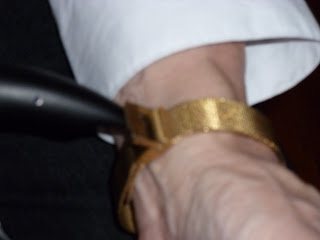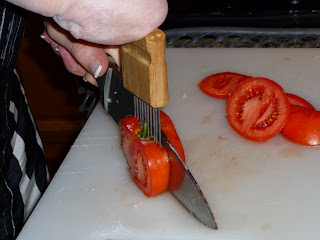Without a prosthesis:
First the traditional buckle style watchband:
Positioning is important for my success. I wear my watch on my left wrist and will typically support my left forearm on my left thigh to stabilize the area so that I can best maneuver my residual limb. I 'grasp' the watch with the crook of my right elbow and position the watch on my wrist.
Then I manipulate the band so that I will be able to feed the end into the buckle.
Once it is through the buckle, I pull it the remainder of the way using the terminal end of my residual limb and my left thigh.
I use my residual limb to push the strap though the placement holders once through the buckle
so the watch is completely fastened.
And now the double hinge metallic strap:
Again, positioning is a key to sucess. I drape the watch over my wrist using my residual limb. My left forearm is supported on my thigh to stabilize my arm during the task.
I align the strap onto the prongs of the clasp
and use my residual limb to push the clasp and hook it together
Then I push the second hinge over the first in the same fashion
And it's on!
With a prosthesis:
The traditional buckle watchstrap:
I drape the watch on my wrist, pinch the strap, push and then pinch and pull it to get it through the buckle.
And finally the double hinge watchstrap:
I grasp the watch with the terminal device and position it on my wrist.
I line up the hooks on the clasp and then pinch
Then I fold over the second hinge and repeat the process
And the watch is on.
I must confess that photographs give the appearance of simplicity. I have spent many hours practicing these techniques, beginning when I was very young. Don't be discouraged... any skill worth acquiring is worth working toward with diligence! And being maximally functionally independent is a worthy goal.
Next to be published will be buttoning the cuff button ... Check back next week!!
In the meantime, be well, be blessed.






















































































